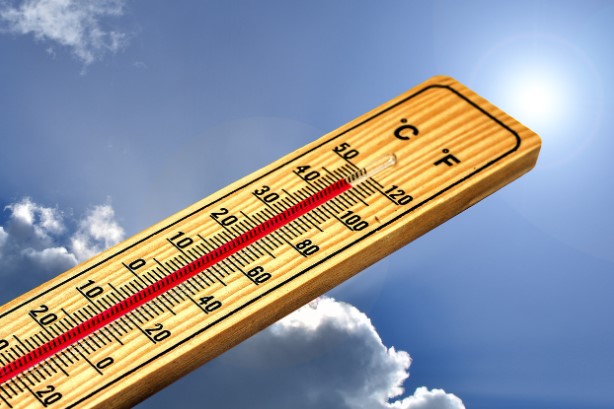County shares tips to help stay cool as temperatures soar
Triple-digit temperatures in the forecast starting tomorrow in North County
– As temperatures soar through summer heat waves in San Luis Obispo County, the San Luis Obispo County Public Health Department encourages residents to protect themselves from heat-related illness and to check on those who may be especially at risk. This includes young children, the elderly, people with health conditions, and people who work outdoors. Triple-digit temperatures are in the forecast starting tomorrow.
“Staying cool isn’t just about comfort: heat-related illness can be very serious and even deadly,” said County Health Officer Dr. Penny Borenstein. “This is true for our most vulnerable neighbors and even for otherwise healthy people who work or exercise outdoors in the heat.”
To reduce the risk of heat-related illness, health officials advise staying cool, staying hydrated, and staying connected during extreme heat waves.
Stay cool:
- Stay in air-conditioned buildings as much as possible. If you do not have air conditioning at home, consider visiting air-conditioned public places like libraries, malls, or cooling centers. Even a few hours of air conditioning can help your body cope. While fans can provide comfort, they are not effective at preventing heat-related illness when temperatures reach the high 90s or above.
- Avoid exercising or working outdoors during the hottest times of day. Take advantage of cooler early morning and later evening hours. If you must exercise or work outdoors in the heat, pace yourself and take frequent breaks.
- Wear lightweight, light-colored, loose-fitting clothing. Outdoors, wear a wide-brimmed hat.
- Take cool showers or baths. Keep a spray bottle of water in the refrigerator to spray yourself with cool water if needed.
Stay hydrated:
- Drink more water than usual. Don’t wait until you are thirsty to drink more water.
- Avoid alcohol and sugary beverages. Drink cool water instead.
- If you are working or exercising outside, drink two to four cups of water per hour.
Stay connected:
- Check on neighbors, family, and friends who are especially at risk. This includes young children, the elderly, people with health conditions (including mental health conditions), people who work outdoors, and people who do not have access to air conditioning. If you are at risk, ask someone to check on you.
- If you must work or exercise outdoors in the heat, use a buddy system. Monitor your buddy for signs of heat-related illness (see below) and ask them to do the same for you. If you see signs of illness, stop work or exercise and move to a cooler environment.
- Remember to check on pets. Pets can get dehydrated quickly, so give them plenty of fresh, clean water. Make sure they have a shady place to get out of the sun, be careful not to over-exercise them, and keep them indoors when it’s extremely hot.
- Never leave people or pets in closed, parked cars.
- If you see signs of heat-related illness, take action immediately.
When the body becomes too hot and is not able to cool itself, risk increases for heat exhaustion and heat stroke.
Heat exhaustion symptoms include:
- Heavy sweating
- Weakness
- Cold, pale, and clammy skin
- Fast, weak pulse
- Nausea or vomiting
- Fainting
Heat stroke symptoms include:
- High body temperature (above 103°F)
- Hot, red, dry or moist skin and NOT sweating
- Rapid and strong pulse
- Confusion and possible unconsciousness
If you see signs of either illness, immediately move the person to a cooler area to lie down and rest. Cool the person with a cool shower, bath, or wet cloth.
In the case of heat exhaustion, the person may sip cool water. If the person vomits repeatedly, seek medical attention. Most people recover from heat exhaustion without medical attention.
In the case of heat stroke, remember: heat stroke is a medical emergency. Immediately focus on helping the person cool down and then call 911 or get someone else to make the call. A person suffering from heat stroke should not drink liquids.
Hot weather tips for pets
The County of San Luis Obispo Animal Services Division is reminding pet owners to take proactive measures this summer to protect their companion animals from the potential dangers of extreme temperatures.
“With pets being vulnerable to heat-related illnesses and injuries, it is crucial to prioritize their well-being and take appropriate safety precautions,” said County Animal Services Manager Eric Anderson.
“Pets who are exposed to high temperatures are susceptible to heatstroke and other serious injuries. We are pleased to offer several common-sense tips for responsible pet owners to follow during the hot weather that we will likely see over the next few months.”
- Never leave pets unattended in a vehicle. Even on moderately warm days, temperatures inside a vehicle can rapidly rise to dangerous levels. Leaving pets unattended in a parked car—even with the windows cracked—can lead to heatstroke or death.
- Keep pets hydrated. Just like humans, pets need plenty of fresh water to stay hydrated. Ensure that clean water is always available, especially when outdoors. Carry water with you during walks and outings to prevent dehydration.
- Provide shade and ventilation. Create a comfortable, shady spot for your pet to rest and cool down when spending time outdoors. Avoid leaving your pet in direct sunlight or confined spaces without proper airflow, as this can lead to heat exhaustion or heatstroke.
- Limit outdoor activities. During peak heat hours, typically between 10 a.m. and 4 p.m., reduce strenuous activities such as walks or exercise. Plan for early morning or late evening outings when temperatures are cooler. Be mindful of hot pavement and asphalt, as it can burn your
pet’s paws. - Recognize signs of heatstroke. Familiarize yourself with the signs of heat exhaustion and heatstroke in pets, which may include excessive panting, drooling, lethargy, vomiting or collapse. If you suspect your pet is suffering from heatstroke, immediately move them to a cool area, offer water, and contact a veterinarian.
- Offer cool treats. Providing frozen treats is a fun and cool way to help your pets beat the heat.
You can make homemade “pupsicles” for your dog by freezing chicken broth inside of a Kong-style toy. Chickens and small animals like rabbits and Guinea pigs love frozen fruits and vegetables.























